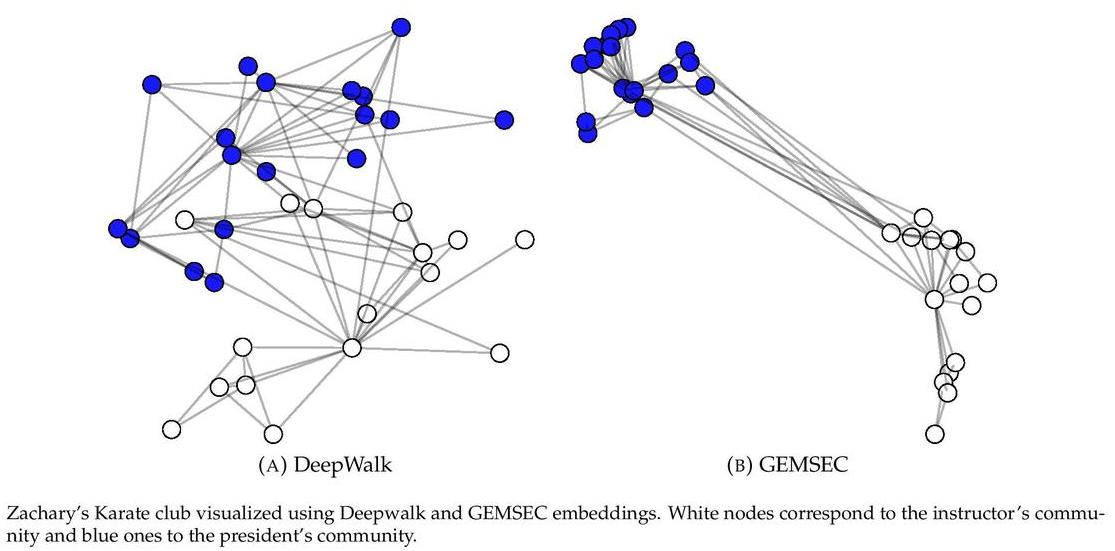GEMSEC is a graph embedding algorithm which learns an embedding and clustering jointly. The procedure places nodes in an abstract feature space where the vertex features minimize the negative log likelihood of preserving sampled vertex neighborhoods while the nodes are clustered into a fixed number of groups in this space. GEMSEC is a general extension of earlier work in the domain as it is an augmentation of the core optimization problem of sequence based graph embedding procedures and it is agnostic of the neighborhood sampling strategy (first/second-order random walks).
GEMSEC is available in the NetworkX extension package Karate Club.
The second-order random walks sampling methods were taken from the reference implementation of Node2Vec.
This repository provides a reference implementation for GEMSEC as described in the paper:
GEMSEC: Graph Embedding with Self Clustering. Benedek Rozemberczki, Ryan Davies, Rik Sarkar and Charles Sutton . ASONAM, 2019. https://arxiv.org/abs/1802.03997
The datasets are also available on SNAP.
If you find GEMSEC useful in your research, please consider citing the following paper:
>@inproceedings{rozemberczki2019gemsec,
title={{GEMSEC: Graph Embedding with Self Clustering}},
author={Rozemberczki, Benedek and Davies, Ryan and Sarkar, Rik and Sutton, Charles},
booktitle={Proceedings of the 2019 IEEE/ACM International Conference on Advances in Social Networks Analysis and Mining 2019},
pages={65-72},
year={2019},
organization={ACM}
}The codebase is implemented in Python 3.5.2 | Anaconda 4.2.0 (64-bit). Package versions used for development are just below.
networkx 2.4
tqdm 4.19.5
numpy 1.13.3
pandas 0.20.3
tensorflow-gpu 1.12.0
jsonschema 2.6.0
texttable 1.5.1
python-louvain 0.11
The code takes an input graph in a csv file. Every row indicates an edge between two nodes separated by a comma. The first row is a header. Nodes should be indexed starting with 0. Sample graphs for the `Facebook Politicians` and `Facebook Companies` datasets are included in the `data/` directory.
The models are defined in a way that parameter settings and cluster quality is logged in every single epoch. Specifically we log the followings:
1. Hyperparameter settings. We save each hyperparameter used in the experiment.
2. Cost per epoch. Embedding, clustering and regularization cost are stored depending on the model type.
3. Cluster quality. Measured by modularity. We calculate it both for the classical and neural clusterings per epoch.
4. Runtime. We measure the time needed for optimization and data generation per epoch -- measured by seconds.
Learning of the embedding is handled by the src/embedding_clustering.py script which provides the following command line arguments.
--input STR Input graph path. Default is `data/politician_edges.csv`.
--embedding-output STR Embeddings path. Default is `output/embeddings/politician_embedding.csv`.
--cluster-mean-output STR Cluster centers path. Default is `output/cluster_means/politician_means.csv`.
--log-output STR Log path. Default is `output/logs/politician.log`.
--assignment-output STR Node-cluster assignment dictionary path. Default is `output/assignments/politician.json`.
--dump-matrices BOOL Whether the trained model should be saved. Default is `True`.
--model STR The model type. Default is `GEMSECWithRegularization`.
--walker STR Random walker order (first/second). Default is `first`.
--P FLOAT Return hyperparameter for second-order walk. Default is 1.0
--Q FLOAT In-out hyperparameter for second-order walk. Default is 1.0.
--dimensions INT Number of dimensions. Default is 16.
--random-walk-length INT Length of random walk per source. Default is 80.
--num-of-walks INT Number of random walks per source. Default is 5.
--window-size INT Window size for proximity statistic extraction. Default is 5.
--distortion FLOAT Downsampling distortion. Default is 0.75.
--negative-sample-number INT Number of negative samples to draw. Default is 10.
--initial-learning-rate FLOAT Initial learning rate. Default is 0.001.
--minimal-learning-rate FLOAT Final learning rate. Default is 0.0001.
--annealing-factor FLOAT Annealing factor for learning rate. Default is 1.0.
--initial-gamma FLOAT Initial clustering weight coefficient. Default is 0.1.
--final-gamma FLOAT Final clustering weight coefficient. Default is 0.5.
--lambd FLOAT Smoothness regularization penalty. Default is 0.0625.
--cluster-number INT Number of clusters. Default is 20.
--overlap-weighting STR Weight construction technique for regularization. Default is `normalized_overlap`.
--regularization-noise FLOAT Uniform noise max and min on the feature vector distance. Default is 10**-8.
The following commands learn a graph embedding and cluster center and writes them to disk. The node representations are ordered by the ID.
Creating a GEMSEC embedding of the default dataset with the default hyperparameter settings. Saving the embedding, cluster centres and the log file at the default path.
$ python src/embedding_clustering.pyCreating a DeepWalk embedding of the default dataset with the default hyperparameter settings. Saving the embedding, cluster centres and the log file at the default path.
$ python src/embedding_clustering.py --model DeepWalkTurning off the model saving.
$ python src/embedding_clustering.py --dump-matrices FalseCreating an embedding of an other dataset the Facebook Companies. Saving the output and the log in a custom place.
$ python src/embedding_clustering.py --input data/company_edges.csv --embedding-output output/embeddings/company_embedding.csv --log-output output/cluster_means/company_means.csv --cluster-mean-output output/logs/company.jsonCreating a clustered embedding of the default dataset in 32 dimensions, 20 sequences per source node with length 160 and 10 cluster centers.
$ python src/embedding_clustering.py --dimensions 32 --num-of-walks 20 --random-walk-length 160 --cluster-number 10License



